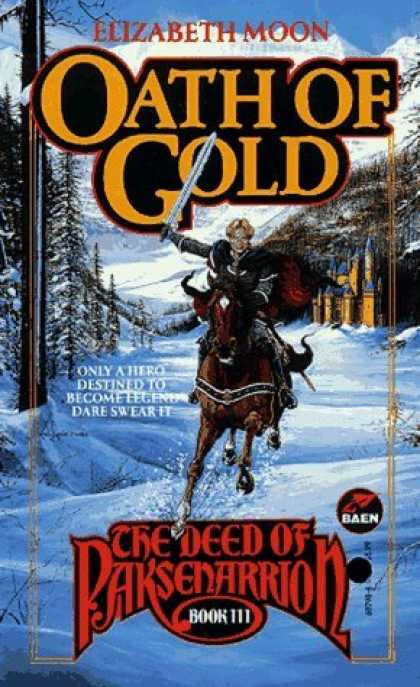Oath of Gold is the third and final book in The Deed of Paksenarrion by Elizabeth Moon.
So what did I think of when reading it?
Don’t be surprised if the readers, aka the players, figure out your plot points and hidden agendas before you’re ready for them. I knew what the big twist here was probably fifty to sixty pages before it was ‘officially’ revealed in the book and those parts I read in between the figuring it out and the big reveal were almost ‘wasted’ to me.
If the players figure out that the local Duke they’ve been working for is actually a lost half elf heir, then run with it then. Don’t make them travel all around the campaign setting collecting little clues and bits of lore to verify it unless you are absolutely certain those pieces of the puzzle are going to blow the players out of the water. You don’t want to bore the group with how smart you are.
In terms of the lost heir, this is a common theme and dates back to the big baddie of them all, the Lord of the Rings. This is not a problem. Some Game Masters are unhappy if their campaign has any links to the original material. They feel that elves, dwarves and Halflings are all overdone and that only by having a ‘pure’ campaign setting, can they ‘evolve’ their campaign.
If you’re playing with new people who’ve just seen those movies on Blue Ray though, they make excellent ‘touch’ points. The reason authors like Terry Brooks and Dennis L. McKiernan are essentially able to add fan fiction additions to the setting and sell, is because people like these common fantasy themes. Some of the more esoteric settings like Talislantia and Journe might be so off the path that none of the players can relate to them and thus languish.
Use that enthusiasm the players bring to the table and when possible, provide them your own recommended reading or movie list if you find that those ‘old styles’ don’t necessarily mesh with your own campaign running. Nothing worse then bringing new players to the game who are eage to play reclusive elves who are master of the bow only to learn that in your setting based on Dragon Age that all elves are slaves.
Another thing I though, was that songs are a part of many a campaign setting. While I’m not saying you as a GM need to write out some golden oldies hits, songs are like legends and lore in the campaign setting and can reveal the character of the setting itself. By writing out a few songs and insuring that the players know them, the GM can provide further bits of culture to the players so that they have a better, firmer grip of the setting they live, fight, and die in.
In terms of power source, Paks, being an unordaned paladin in any official church sense, is accepted by the official members as her powers are given to her straight for the deities. She gains a sense of purpose and a sense of right and wrong that make her know where she should be and where she should go.
In Dungeons and Dragons 4th edition, and to a lesser extent previous editions, characters are defined by their power source. Paks would be ‘divine’. In such an instance, the Game Master can use that divine power source as a source for pushing the party in a certain direction. It allows the players to have a patron larger than any one particular individual while still giving them plenty of space to work.
4th edition for example, has tied psionics into the Far Realms and the GM could easily substitute a call to action against local aberrations as opposed to a paladin being nudged to go a certain direction.
In terms of Paks abilities, one of them is to sense evil, or at least powerful evil. When she meets the Duke’s intended, the woman sets off the alarms in Pak’s head. If Paks had just been a regular warrior, then that plot line could’ve have gone on for several books being built up in the background. Paks takes care of it in a few pages.
This is just a reminder that you need to refresh yourself with the abilities of your players. If you design an adventure around certain plot points that the players are able to easily overcome or avoid thanks to their abilities, you’ve missed something in the preperation. While some GMs are happy with a result like this because it can showcase the players own unique talents and abilities, be sure that’s why you’re designing the encounter that way in the first place.
As a game master, the weight of the game often falls upon the game master’s shoulders and to create what is not needed is essentially a waste of time.
In the end, the three volume series, The Deed of Paksenarrion costs me $3.00 from Half Priced books and was well worth those funds. If you’re looking for something that has echoes of The Lord of the Rings with a more military ring to it and a quicker progress, you might enjoy the Deed of Paksenarrion.
Subscribe to:
Post Comments (Atom)






No comments:
Post a Comment